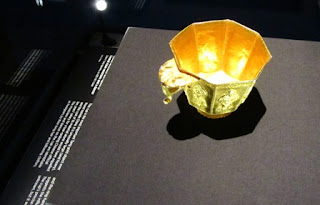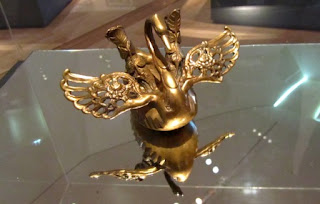For a long time, we watched the painstaking construction of the ArtScience Museum at the Marina Bay waterfront. Was it supposed to be an abstract depiction of a lotus flower or a hand reaching out to pluck clouds off the sky? What it was meant to look like did not matter because finally it was completed and the ArtScience Museum was born.
When the entrance fee to view the exhibits was announced I was disappointed that it was set at such a high price. At almost $30 per person, that was enough to put off a visit. Why, the National Palace Museum in Taipei with all that world-class treasure from China's historical past only charged a fee of less than $10 and for that small amount we could view all the amazing treasures that thankfully were saved from destruction by the Communists.
When at last a friend and I decided to go and see the exhibitions at the ArtScience Museum and there were three of them, we found it painful to fork out $60 for a few hours to spend inside this museum. At the end of our visit, however, we changed our minds and were really glad we we went. Here's why:
Entering the museum.
At the basement of the museum to view the artifacts on display from the Tang Shipwreck Treasure, Singapore’s Maritime Collection that was acquired through the generous donation of the Estate of Tan Sri Khoo Teck Puat, one of our well-know philanthropists.
This exhibition showcased some 60,000 objects salvaged from a sunken ninth-century Arab dhow comprising ceramics, gold and silver that had lain for centuries for more than 1,100 years. The shipwreck was found near Indonesia's Belitung Island in 1998, confirming trade between China and countries in the Persian Gulf. This find is considered of utmost importance in the late 20th Century. Here is a replica of the ship:
and small artefacts like this inkstone used in calligraphy where a stick of ink is ground to produce the ink that collects in the ink well.This find indicates that there might have been a scholar on board the sunken ship.
Gold jewellery,
a small coin and a mirror from Java that might have been acquired during the voyage.
West Asian pottery that might have come from Iraq known to contain date syrup.
Chinese coins minted from 621 onwards.
Large jars, some encrusted with corals.
An incense burner with the opening playfully in the form of a man or boy prying open the mouth of a lion.
Jars were probably used also for packing the changsa bowls found.
Pottery found were decorated with birds, plants, flower and fish motifs.
Probably wine jars still in good condition.
The Belitung ewer, a meter tall with West Asian designs.
Beautifully glazed bowls.
Cups with 'drinking straw' - actually a clay tube at the side that I did not imagine was invented centuries ago. The hole at the bottom is concealed by a model of a fish or turtle.
Spot the fish at the bottom of the cups?
Silver boxes with intricate laced designs.
Another mirror with 'bagua' designs.
Gold containers! Gasp.
You have till the end of July to see these fantastic treasures and learn about the quality of trade between China and West Asia centuries ago.
After spending an hour or so admiring the Tang treasures, we walked over to the Van Gogh Exhibition on the same level. This exhibition is on until October 2011 and is the world touring premiere of Van Gogh Alive - The Exhibition, presented by Grande Exhibitions of Australia and VisionsCom of France.
Some people said that viewing 3000 gigantic slides of Van Gogh that were projected onto walls and ceilings of a large hall in sync with haunting classical music is not like seeing the real thing. I went in with an open mind and all I can is say is that you can enjoy Van Gogh in many ways and this is definitely an experience that should not be missed. It is also not an exhibition where you walk through in ten minutes. You have to sit there surrounded by the sight and sound of the show to appreciate Van Gogh's work down to the minute details of the dots and strokes that we often do not see when seeing his work in print. We stayed for about 20 minutes. The paintings showcased were from 1880 - 1890 produced during the most prolific period of his life.
The last exhibition was on the third floor of the museum and it boasts of the largest collection of the work of Salvador Dali ever exhibited in Singapore and it ends on 30 Oct 2011. My friend who has seen exhibitions of his work in another country was impressed by the size and variety of the exhibits. I am not a Dali fan. He is an artist that dapples in everything it seems - paintings, sculpture, jewellery, furniture, decorative items - 250 items displayed in ten galleries. I am not a fan of surrealism and though I was impressed as well, I only enjoyed these items here:
This is a swan.
Turned upside down, the swan becomes an elephant.
Sculpture of Alice in Wonderland.
Me in one of those mirrors that distort you form with a sounds of a multitude of clocks ticking away behind me.
Gold jewellery.
Modelled after the lips of Mae West, the predecessor of Marilyn Monroe and Lady Gaga.
Three-legged chair.





































2 comments:
Very beautiful photos. Hope to visit one day now that they have reduced the price of the tickets.
Yes, even at that high price I felt that it was worth it. But art should be made available to all and not only to those who can afford to pay the price and I am glad to learn from today's papers that the ArtScience museum has dropped the ticket price by more than half. That is really a laudable move and I will certainly look out for more exhibitions there in future. Lindy, you are so lucky to be able to visit museums overseas and see all those things that we can only read about. Cheers and have a good weekend both of you, Alice and Lindy.
Post a Comment